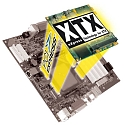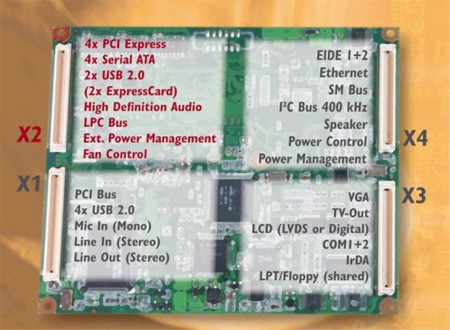Consortium updates XTX computer-on-module spec
Aug 18, 2006 — by LinuxDevices Staff — from the LinuxDevices Archive — 4 views The XTX Consortium has released revision 1.1 of the specification for XTX, one of several alternative upgrade paths to the popular ETX computer-on-module (COM) standard. The latest revision includes the complete definition of all signals as well as detailed mechanical descriptions, according to the consortium.
The XTX Consortium has released revision 1.1 of the specification for XTX, one of several alternative upgrade paths to the popular ETX computer-on-module (COM) standard. The latest revision includes the complete definition of all signals as well as detailed mechanical descriptions, according to the consortium.
Like ETX modules, XTX modules are highly integrated and compact SBCs (single-board computers) that plug into custom circuit boards containing additional application-specific functions and peripheral interface connectors. The goal of XTX, according to the consortium, is to provide an easy and cost-effective upgrade to ETX that allows companies to enhance their system designs without major redesigns of existing carrier boards.
Fundamentally, XTX replaces the ISA bus found on the ETX X2 connector with four PCI Express lanes, four serial ATA channels, two additional USB ports, and other functions. For ETX-based system designs that don't use ETX's ISA bus signals, XTX modules can plug directly into existing application baseboards. Revision 1.1 adds two new signals to enhance ACPI battery management capability, according to the consortium.

XTX connector allocation
(Source: Congatec)
The XTX Consortium says it recently completed a detailed simulation of the Hirose FX8 connector specified for XTX modules. With PCI Express data rates of 2.5 GB/sec, the connector becomes a critical element in the data path. The simulation model included the complete signal pathway originating at the chipset, through the FX8 connector and all the way to a PCI Express device on the application-specific baseboard.
The results of the simulation verified that XTX can sustain PCI Express data rates over a signal length of more then 10 inches on the baseboard, according to the consortium. The simulation results are discussed in the revision 1.1 specification, which is available for free download here.
Further details on XTX are available in our previous coverage, and at the spec's website.
This article was originally published on LinuxDevices.com and has been donated to the open source community by QuinStreet Inc. Please visit LinuxToday.com for up-to-date news and articles about Linux and open source.